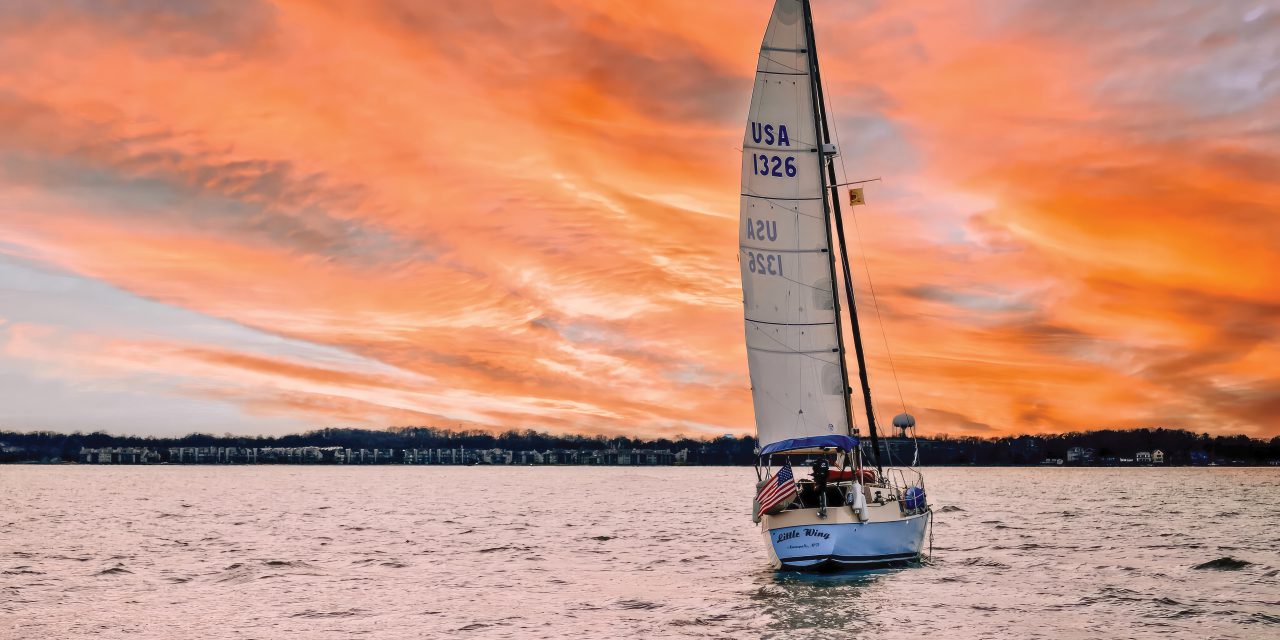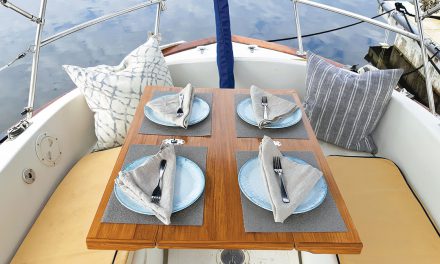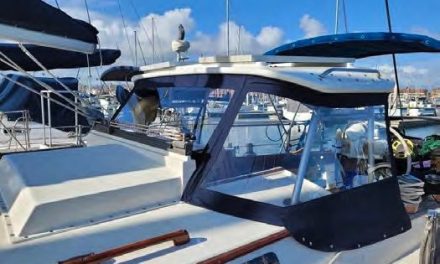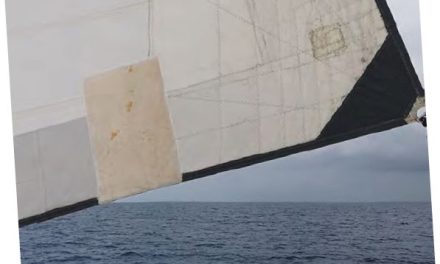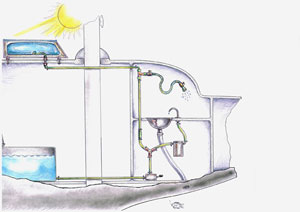When the pandemic scuttles her study abroad plans, a college student undertakes an extensive boat refit.
Issue 150: May/June 2023
You might think that after growing up on old boats, I would have opted for something newer when I got a boat of my own. The opposite was true.
I spent a lot of time on a big, fat, gaff-rigged wooden ketch as a kid. My bunk was practically in the anchor locker and my feet often shared a blanket with the muddy chain. The teak decks overhead leaked no matter how much oakum my dad stuffed in between the planks. Around age 10, I was climbing up the mast to varnish or crawling behind the engine to hand a wire to someone on the other side.
Launched in 1963, Sea Spirit was a constant project. She was slow, an incredible challenge to dock, and lacked most of the amenities that are nearly ubiquitous on modern vessels.

The exterior of the author’s 1974 steel boat, before the extensive refit began.
These experiences may have quickly led others in the direction of shiny new plastic boats, but growing up on Sea Spirit only inspired my love of the opposite. Because despite the gargantuan effort required to keep her afloat, there was never a day on the water that she didn’t turn heads, and whenever we pulled into marinas all the kids begged their parents to let them go see our “pirate ship.”
I knew that someday when I got a boat of my own, I wanted her to stand out like Sea Spirit did, and what better to accomplish that end than another good old boat?
Before the pandemic, I was deliberating about whether to commit to a study abroad program in Russia or one in Trinidad for the spring of 2021. My dad suggested that if I went to Trinidad, I could spend the following summer sailing home to the Chesapeake — the thinking was that I could find a boat and have a family friend deliver it to Trinadad so I could sail it back. Never mind the logistics involved; I was sold.
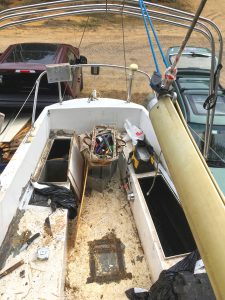
Little Wing’s cockpit was a work zone as the refit got underway in spring 2020.
In March 2020, two months after I committed to the Trinidad program, the pandemic sent me home to Maryland and I went searching for my boat. I scoured classifieds and drove around yards, eyeing “for sale” signs from the safety of the car. And then, through sheer happenstance, the boat found me. My family was selling a farm in southern Maryland, and the buyer asked if the tractor could be included in the sale. My dad, knowing I was in the market for a boat, said they might be able to work out a trade — if the buyer just so happened to have one. He did.
I saw the boat once before the trade was finalized, and only from the outside because the cabin had been locked and the key lost nearly two decades prior. But from a first glance she fit my criteria — quirky — so I went for it. Plus, I have a soft spot for yard queens, and this was my opportunity to save one.
As it quickly became apparent, the boat that I now owned was far quirkier than I had imagined. Built in 1974 in the Netherlands by a company that only existed for a few years, she is 30 feet of steel and designed for ice. Her overbuilt rail and rough edges remind me of a ferry, and her hard chines vaguely resemble those of an Opti. She has a shoal-draft full keel that measures over a foot wide at the leading edge and a barn door rudder. And after sitting on the hard for 20 years, nothing aboard worked — not the engine, the electrical, the plumbing, nothing. I already had mental plans to take this nameless piece of steel on some sort of adventure, study abroad or not, so the full-scale refit was on.
Phase One: Demolition
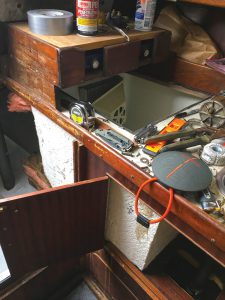
The boat’s original icebox was glued to the underside of the galley counter.
Step one was finding a spigot for the power washer. That ate up 30 minutes, providing my first lesson in the nature of DIY projects. With the deck free of its thick layer of pine needles and bird poop, I began to formulate a plan, starting with throwing out moldy gear, evicting wasps, and mapping out internal systems. After discovering that the manufacturer of the boat’s head no longer existed and parts would be impossible to come by, the head was among the first items to go, along with the rest of the decades-old plumbing.
The old holding tank beneath the V-berth was, for reasons unknown to me, full of what I initially identified as rainwater. With pump-out services unavailable, I used a crème brûlée torch sourced from my family’s kitchen to loosen the uppermost hose and a siphon to drain it enough that I could lift the plastic box, then I dumped what remained into a bucket. At that point, it became apparent it probably wasn’t rainwater.
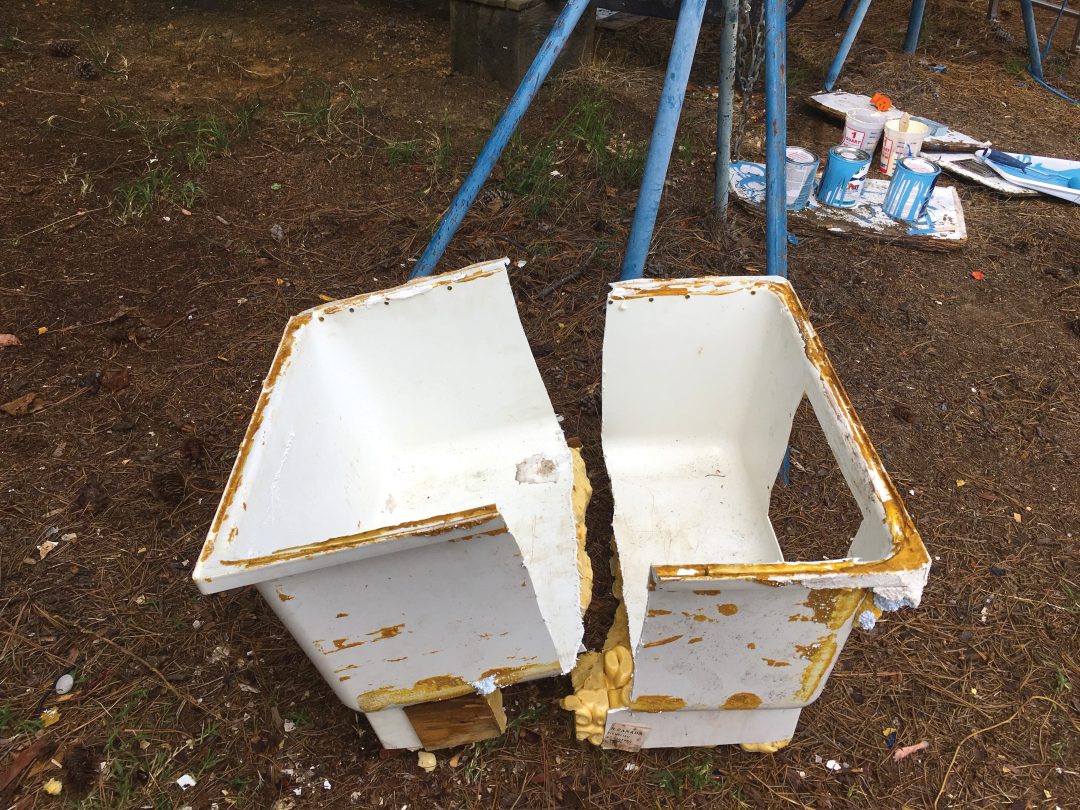
The icebox was cut in half and removed.
The icebox was also on the docket for removal. Initially, I hoped to remove the ancient glue barely holding it to the underside of the galley counter and seal it back in, but even after ripping out its thick layer of insulation it was stuck on a steel rib and refused to come out. In a moment of frustration, I cut the thing in half with a Fein Multimaster tool. Later, I chose a Dometic electric cooler secured in front of the engine step as a refrigerator. My dad and I selected the cheapest utility tub at Home Depot, sealed it in place where the icebox used to be, and designated it as dry goods storage.
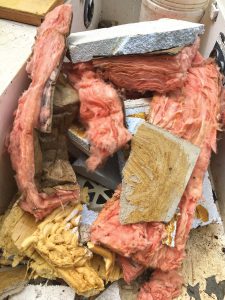
All of the 1970s-era insulation around the icebox was removed as well.
Rotten wooden bunks, veneer siding, and insulation were removed as well, sometimes violently. The 30 gallons of diesel that had mysteriously found its way into the water tank, a compartment in the keel, were removed with a hand pump. The corroded 10-gallon fuel tank loosely supported by plywood and nails was discarded without a second thought, as were the two batteries that my dad and I failed to revive. Then there was the engine.
This rust bucket of an engine was a 2-cylinder iron block diesel with a crank start and a flywheel about 2 feet wide, weighing around 600 pounds, and my dad and I were not inclined to pay for a crane. The plan we devised involved strapping a come-along to the boom, lifting the engine with that, and then using the boom to swing it over the side. The trouble was, the cabin lacks a sliding overhead hatch, so once the engine was hanging in the companionway, it had to be muscled out the opening. But the plan worked, even if it was nerve-wracking.
Phase Two: Reassembly

The old engine was removed by strapping a come-along to the boom, lifting the engine with it, and swinging the engine over the side of the boat.
With the cabin now essentially empty, I painted the storage lockers and inside the engine compartment, working bow to stern. Despite warnings on forums and paint data sheets proclaiming that exposed steel would rust within 24 to 48 hours, most of the exposed steel I found was only lightly rusted or rust-free, save a few unfortunate corners. I still haven’t figured out exactly why that was, but my guess is that the entire hull was flame-sprayed with zinc or even aluminum, a critical step in the boat’s construction that may be the only reason she was salvageable at all.
Most compartments had at least some surface rust, however, so I started by removing as much as I could with a wire brush and treating it with Ospho, a rust converter. The next day, I applied a coat of Rust-Oleum clean metal primer, and the next, Bilgekote. I worked in phases, so on any given day I would be painting one compartment, priming the next, and treating rust in the third.
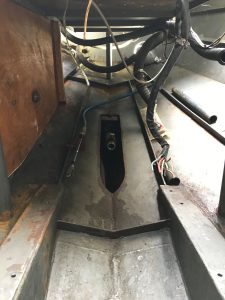
The empty engine compartment after the old engine was removed.
With the interior mostly painted, it was time to start reassembling everything. We hired a welder to add some through-hulls, cut a hole for a shorepower plug, and addressed some other odds and ends. The nice thing about steel boats is that you can create holes or attach accessories just about anywhere — if you can weld.
One of my dad’s top priorities was getting the Dometic air conditioner in, so we installed it in one of the storage compartments and later ran a vent next to the mast support. We ordered a custom 30-gallon aluminum fuel tank that was oriented vertically to fit into a space closer to the boat’s center of gravity, rather than far astern as the old one had been. Despite all our careful measurements, we still had to grind off a few millimeters of a steel rib to squeeze it in. We also installed the binnacle — which came unattached to the boat — back into the cockpit and wired a B&G Vulcan chart plotter on top of it.
Getting the new engine in was more nerve-wracking than taking the old one out. We had no desire to bump the brand new 30-hp, 3-cylinder Volvo diesel against the hull, so although we used the same operation in reverse to move it aboard, we were much more cautious. Luckily, it was less than half the weight of the original, so maneuvering it into the cabin was far easier. Once it was inside, we snapped more than a few drill bits and taps creating new holes for the engine mounts in the inch- thick steel engine rails. Then my dad adjusted the mounts while I crawled behind the engine with a feeler gauge to align it with the new shaft.

The engine compartment looks fresh after being rust-treated, primed with Rust-Oleum, and painted with Bilgekote.
After a full day, we thought we finally got it aligned, only to realize that the engine was so steeply angled that it appeared to be nosediving into the bilge. After some deliberation and close inspection of part numbers, it became apparent that the wrong transmission had been delivered — we ordered one with a straight angle but had received one with a 7-degree down angle.
While waiting for the correct transmission to arrive, I worked on painting the exterior. Sandblasting and starting from bare metal was not an option, given the $20,000 estimate we got, so instead, I sanded and crossed my fingers that the bottom layers of paint were well adhered. My research suggested that I should use Amercoat 235, a two-part epoxy primer made by PPG, for areas on the outside of the hull that lacked paint. I called dozens of distributors to locate it and had many conversations that included a representative asking what shipyard I was associated with. I ultimately drove a four-hour round trip to get my hands on 2 gallons of it.
After applying the Amercoat 235 where necessary, I rolled and tipped the freeboards a bright sky blue — Pettit’s EZ-Poxy Bikini Blue, to stand out — and painted the bottom with steel-safe Pacifica Plus. The night before the launch, while she was hanging in the straps, a mere four months after the project began, I frantically scraped and painted the bottom of the keel and put her name on: Little Wing.

After much work, Little Wing is put back into the water for the first time in 20 years.
The Launch and First Sea Trial
With fresh paint (minus the deck), a new drivetrain, fuel tank, air conditioner, and a starting battery, Little Wing went back into the water for the first time in 20 years. With the straps still hovering beneath the hull, I climbed aboard and was greeted by 6 inches of water in the cabin and a firehose gushing from the V-berth. She was promptly lifted back out of the water. Soaking wet and on the verge of tears, I found the culprit. We had put new seacocks on all the through-hulls that didn’t have plumbing attached yet, and one of them was too large to be screwed on without removing the handle. When the handle was put back on, it was 90 degrees off, meaning that all the times I double- and triple- checked that it was closed, it was actually wide open. I pumped all the water out, closed the offending seacock, and Little Wing was carefully lowered back into the water — with no leaks.
A few days later, my dad and I moved her up to Annapolis from southern Maryland, a long-awaited moment. I had been sleeping on the couch of my family’s increasingly barren farmhouse until the agreed move-out date with the buyer, then in a hotel behind a gas station for the month afterward, and I was looking forward to a change of scenery.
It was quite the sea trial — despite being August on the Chesapeake Bay, a stiff northerly breeze brought temperatures in the 50s and some serious chop. But after an overnight stop at Solomons Island to wait out the weather, we arrived safely and Annapolis became Little Wing’s home for the remainder of the refit.
Phase Three: Rigging, Systems, and Everything Else
For the duration of the fall, I lived aboard my family’s new boat (Sea Spirit’s fiberglass replacement) one marina over from Little Wing, worked on the Woodwind charter schooners to support my West Marine habit, and took my college classes remotely. My enthusiasm for academia fell precipitously as the pressure to finish the refit increased. I started the semester judiciously attending my online classes at a real table with a notebook in hand and ended it listening to lectures like podcasts while I painted the deck. I had to email a professor at one point asking to be excused from class for a morning appointment to get the mast pulled — luckily, all of my professors were supportive of the project, and he found humor in the absurdity of the request.
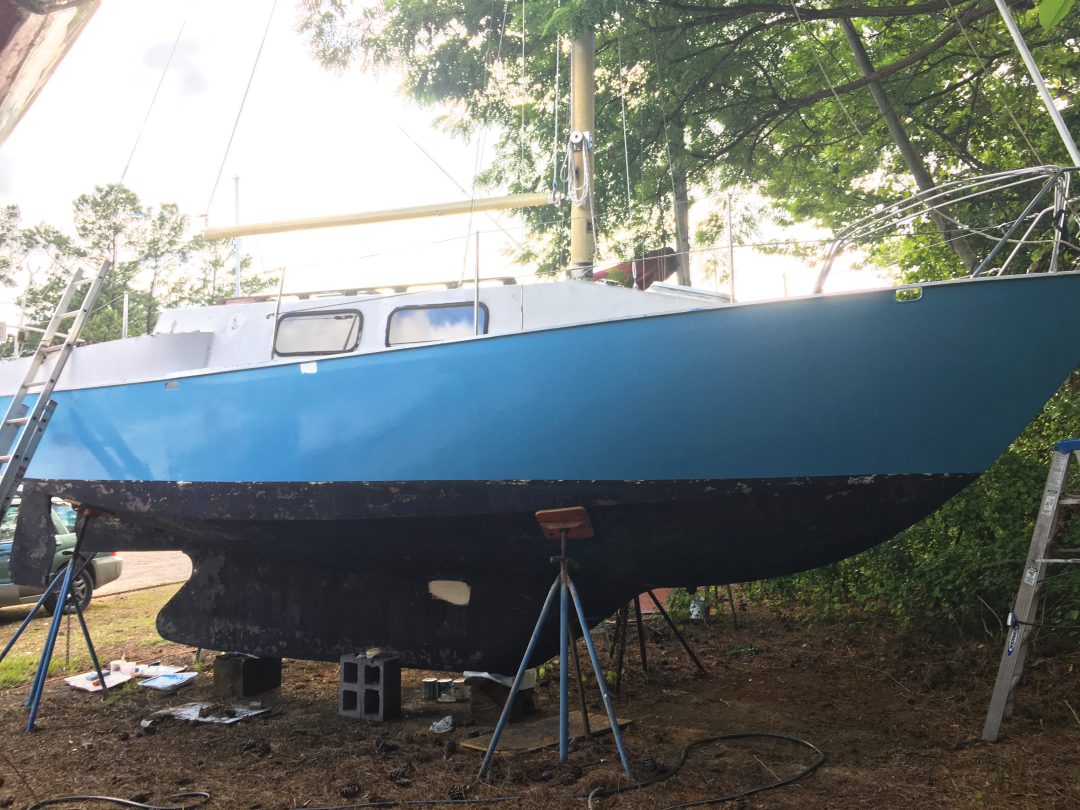
The freshly painted freeboards pop with a bright sky blue.
After the mast was pulled, I was fortunate to be working with a rigging company run by family friends who allowed me to come to the shop and do some of the labor myself to reduce costs. I installed mast steps while they internalized the halyards, replaced the standing and running rigging, and wired masthead electronics — OK, yes, they did most of it.
I frustratingly sprained my ankle on the Woodwind in September, forcing me to focus on less labor-intensive tasks for a while. I laundry-stripped the cushions in a bathtub, serviced the winches, rebedded the hatches, replaced the handrails, and crutched my way into chandleries to hunt down miscellaneous parts while my dad wired up the lights, outlets, and other electronics, and reinstalled the plumbing. He added four house batteries and strapped them down to a marine plywood platform underneath a small nav desk that he built in the quarter berth. The dish rack, with its original Dutch china, was moved from one side of the cabin to the other to make room for his flip-down electric panel design.
A friend sewed dividers from a shower curtain to replace the cumbersome door previously separating the head from the V-berth and saloon. My dad and I settled on a Plastimo flexible water tank to drop down into the compartment in the keel, because painting the old one with water-safe materials and properly resealing it would have been nearly impossible. I got new sails cut by North Sails — a main and a 130% genoa, both decently heavy with two reef points, and thrifted a sail cover.
Painting the deck spanned most of the fall, as I worked piecemeal around rain and dew. Unlike on the freeboards and bottom, there was a significant amount of bare steel, so I opted to roll two coats of Amercoat 235 over the whole thing. After applying the first section of polyurethane topcoat to the starboard side of the cabin, I returned the following morning to find it hadn’t adhered well. I paused the operation until I could find a paint stripper that would remove it without affecting the epoxy Amercoat underneath, and Citristrip was the winning candidate.
I could have sanded it off, sure, but it was my aversion to any excess sanding in the first place that led to the polyurethane failing to stick. I sucked it up and sanded the second time around, and the problem was resolved. Applying the non-skid, the last step, took the longest of all of the painting stages due to the amount of taping involved, and it wasn’t completed until the last minute.
The Final Days

The author applies sealant before reinstalling the hatches.
In the final days of the refit, we came to terms with the fact that if I really intended to go somewhere before I had to return to school, I had to leave now. Between four months spent working on the hard and five months working in the water, it was now December of 2020. Little Wing was essentially a new boat aside from the hull and mast, with all new running gear, fresh paint on almost every square inch, the latest electronics, and entirely new electrical, plumbing, and rigging. Still, she wasn’t done — the new veneer siding wasn’t stained, random corners of the deck remained without a topcoat, the hand- rails weren’t varnished, and above all, I had barely actually tested anything. I’d never anchored her, reefed the sails, set up the radar or autopilot, or used the VHF for more than a single test call.
But the choice was made for me. My study abroad program had long ago been canceled and I had already submitted the paperwork to instead take the spring 2021 semester off from school. I had until August 2021 to go cruising and get back in time for my senior year, and if I waited any longer, I wouldn’t get far. So on Jan. 4, 2021, I stayed up until 4 a.m. moving tools and scraps onto dry land and stowing clothes, cookware, and other equipment in their place.

Little Wing’s revamped saloon looks cozy and inviting.
The following morning, months behind the rest of the snowbirds but less than a year since I first laid eyes on the boat, I officially christened her and cast off the lines with a friend. On the cold winter day that we left, I had only ever sailed her twice. Maybe it was the lack of sleep, maybe it was the cold, or maybe it was the fear that I didn’t allow myself to linger on, but it took a while to register that I’d actually cast off. It didn’t hit me when I popped the champagne, nor when we pulled out of the slip, and not even when my family, who buddy-boated out of Annapolis Harbor with us, finally turned around.
It was when I was peering out of the forward hatch that first night, staring intently at the pitch-black shoreline of Tilghman Island to gauge whether the anchor was dragging, that it started to sink in. Over the next few months, my little piece of steel carried me more than 1,500 nautical miles on paper, but in reality, Little Wing took me much farther than that.
Kelsey Bonham has been cruising the Chesapeake in boats of various sizes for two decades. She is currently based in Norfolk, Virginia, where she and her partner, Nic Bailey, continue to upgrade and sail Little Wing, a 1974 Jachtbouw Noord Nederland Seahawk, year-round throughout the southern bay. Follow them and Little Wing on Instagram @ littlewing_sailing and TikTok @ littlewingsailing.
Thank you to Sailrite Enterprises, Inc., for providing free access to back issues of Good Old Boat through intellectual property rights. Sailrite.com

